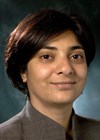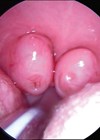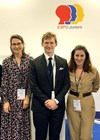Hannah Burns radiates enthusiasm and commitment to improving communications across geographical and political boundaries. When the pandemic hit in 2020, she took to social media to share her thoughts and offered a forum for colleagues. In the midst of the tragic events that unfolded, the results of Hannah’s vision were truly heartening.
If you can think back to early 2020, it was a confusing new world to be thrust into. For those of us on the other side of the globe, the previously annoying factor of distance had an advantage. The pandemic crept more slowly to our shores and, in doing so, gave us a short window to try and prepare for what was already occurring in the major centres throughout Europe and the USA. It was in this light on March 20, 2020, I sent a WhatsApp message to two colleagues, one in the UK and one in USA:

Thus began a worldwide social network of paediatric otolaryngologists.
Early conversations focused heavily on PPE; the shortage, homemade versions, adaptations, difficulties wearing, fit testing and protocols. We explored ways to keep ourselves safe while performing ‘aerosolising’ procedures, and discussed poor ventilation throughout our hospitals. I won’t forget Dan Tweedie’s videos on douching with Betadine (which you can find on his twitter feed @TweedieDaniel). Many in the group described teams being split to keep everyone safe, and staff being furloughed or deployed to help in acute care. Some consultants took on on-call duties for the first time in many years due to the deployment of junior staff.
We shared guidelines, pre-publications, reports, newsletters and, in so doing so, were able to shape local policies in our own hospitals and regions. Invitations were sent out to join virtual meetings and we all learnt very quickly how to turn off our cameras and mute ourselves on Zoom events. Members sent out surveys and collated the responses, further guiding protocols globally. Several publications came out of those surveys [1,2]. With the differences in time zones, it was common to wake up to a string of communication around a topic that had been raised the day before.
We received harrowing first-hand experience from our colleagues in the worst hit hotspots – Spain, New York, Paris. This not only prepared everyone for what might be coming their way, but provided those in hotspots an opportunity to debrief and hopefully feel supported. We discussed paediatric-specific presentations and were relieved when it became clear that children were less likely to get severe disease, but as the numbers climbed there were always exceptions to this rule.
Children, however, continued to have OSA and stridor and to inhale foreign bodies, so alternative treatment options were discussed, along with what was deemed ‘urgent’ and what could wait until the first wave settled. Babies kept being born and even EXIT procedures continued to need to be planned; colleagues talked us through their planning, and we all took our hats off to those who calmly managed these cases.
Many in the group have had personal experience with COVID. In fact, our colleague Ravi Thevasagayam, from Sheffield, was in hospital when I sent the original message - his personal insights into being a patient weren’t lost on any of us and reinforced the importance of staying safe. Other members over 2020 and 2021 openly shared their personal experiences. Unfortunately, not all recovered. The World Health Organisation has estimated between 80,000 to 180,000 healthcare workers have died globally of COVID19 [3]. As of July 2021, Medscape reported 1800 medical personnel deaths from 64 countries [4]; 77 doctors died in Italy alone. On this list were 20 otolaryngologists from all over the world. A study by the Young Otolaryngologists-International Federation of Otolaryngologic Societies (YO-IFOS) identified 24 ENTs in a paper they published in August 2020 [5]. One of these was our colleague, Amjad Salah. We shared this terrible news and, as a group, passed our condolences to his colleagues and family.
As equally important as the serious stuff have been the jokes and many silly stories. We have laughed together which has been good for everyone’s mental health. We celebrated holidays, family photos, milestones, and congratulated colleagues on achievements. As we progressed through lockdowns, isolation and then slowly into the new hope offered by vaccination, we shifted our focus from the COVID-specific to using the community as a ‘brains trust’. We discussed everything from difficult clinical cases to the best nasendoscope. We sought advice for referring patients moving overseas and, in doing so, ensured our patients were always in the best hands.
Moving into 2022, we watched with horror as the war unfolded in the Ukraine but quickly colleagues banded together, provided contacts, offered help both financially and with medical supplies.
Although some of us have met face to face over the years, there are many colleagues in the group who haven’t had this opportunity. The platform has had a levelling effect. It has broken down barriers of age, race, gender, and geography. It has demonstrated the generosity of the many experts we are lucky enough to call colleagues. It has exemplified why diversity is so important.


Dr Eric Levi (Royal children’s Hospital, Melbourne).
Our little community now includes 200 members from 29 countries. It has become easier to ‘phone a friend’, and rare problems are found not to be so rare when you have a global network to call upon. Patients and families can be reassured that the world’s best minds have been asked and are usually very keen to share their story if it is going to help their child or a child elsewhere. Every cloud has a silver lining, and a global pandemic allowed us to engage in technology that has brought us closer together. Although many of us are now enjoying re-engaging in the face-to-face world, virtual communication options hopefully are now seen as valid component for patient care, continuing education, research, and peer support.
References
1. Patel A, Dzioba A, Hong P, et al. Changes to the practice of pediatric otolaryngology as a consequence of the COVID-19 pandemic. Int J Pediatr Otorhinolaryngol 2022;153:111021.
2. Kim DH, Chadha NK, Nguyen LH, Husein M. Personal protective equipment availability and usage amongst pediatric otorhinolaryngologists during the COVID-19 pandemic: An international survey. Int J Pediatr Otorhinolaryngol 2020;138:110349.
3. Health Workforce UHL. The impact of COVID-19 on health and care workers: a closer look at deaths.
www.who.int/publications/i/item/
WHO-HWF-WorkingPaper-2021.1
4. Medscape. In Memoriam: Healthcare Workers Who Have Died of COVID-19.
www.medscape.com/
viewarticle/927976
5. Sowerby LJ, Stephenson K, Dickie A, et al. International registry of otolaryngologist-head and neck surgeons with COVID-19. Int Forum Allergy Rhinol 2020;10(11):1201-8.
Links last accessed November 2022.
Declaration of Competing Interests: HB is a keynote speaker at ESPO 2023. Her travel and attendance costs have been reimbursed by ESPO.











